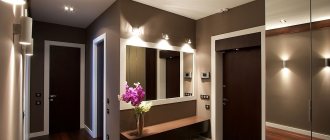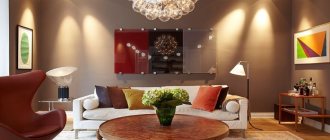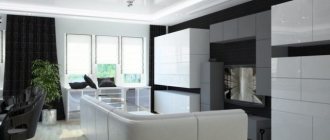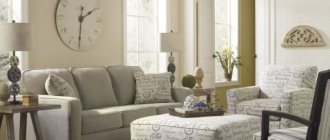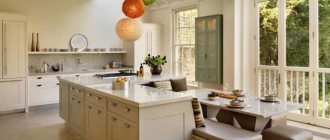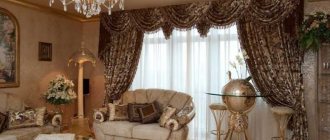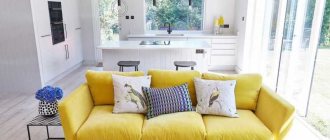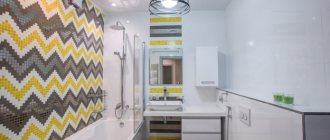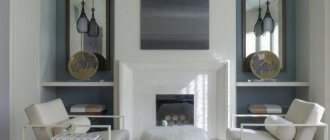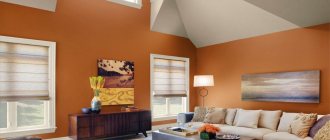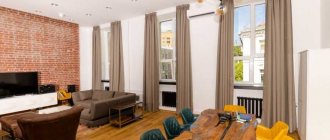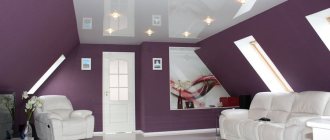Norms and requirements
In order for the light emitted in the living room to be normally perceived by the eyes of visitors, and the stay does not cause excessive visual strain, the installed lighting must comply with the requirements of SanPiN 2.2.1/2.1.1.1278-03 and SP 52.13330.2011, which determine the permissible level of illumination:
- at least 150 Lux for general lighting of the living room;
- not less than 300 Lux for places of increased visual stress (a table for doing handicrafts, if you are making something or repairing something in a certain area of the hall);
- from 300 to 500 Lux when installing an office desk, where you keep documentation, work with papers, or children learn lessons;
- To organize decorative lighting, 20 - 30 lux will be enough.
In addition, to comply with basic safety requirements, the following standards must be met:
- The key switch for switching the living room lighting must be located at a height of 0.8 to 1.7 m in accordance with clause 6.6.31 of the PUE.
- Please note that in accordance with clause 7.1.51 of the PUE, the key switch must be installed at the entrance from the door handle.
- Based on clause 1.7.51 of the PUE, the metal housing of lighting fixtures must be connected to protective grounding in order to protect a person in the event of a violation of the lamp insulation.
- Lighting devices in accordance with clause 2.1.21 of the PUE must be connected to the internal electrical network via terminals, soldering or crimping; connecting them by twisting is strictly prohibited.
When choosing a place to install artificial lighting devices, it is important to consider the appropriateness of a particular position in relation to cabinets, a sofa, a TV and a free passage area. In any case, they should not interfere with your ability to move freely, open doors or perform other daily tasks. If the furniture is not yet in the living room, then after the work is completed, cabinets, shelves and other attributes should not block the path to the distribution of light flux.
Types of lighting
Lighting in the interior is conventionally divided into general, local, decorative and special. You can provide one of the options in the project, as well as several at the same time, the main thing is not to overdo it. All types of lighting in one room can be achieved using different types of devices.
General
The lighting design in the living room to create a large space is selected using lamps of several designs. The lighting is combined. Chandeliers, spotlights or LED strip are used. General lighting of a room is when you need to illuminate all areas of the room and there is no need to highlight special zones.
Sources of general lighting include chandeliers and surface-mounted lamp models; the latter are quite compact and are mounted directly to the ceiling in rooms with low wall heights. Spotlights and LED strips have become the most popular and are successfully replacing massive chandeliers and shades.
When creating combined lighting, a solution to use several lighting devices would be acceptable.
Local
Lighting for the living room is complemented by floor, wall units or a table lamp. The design in the hall is created using these light sources. These devices create bright light at certain points in space: above a desk, sofa or other places.
Related article: Lighting in the corridor: stylish solutions for large and small apartments (+62 photos)
Lighting also plays the role of decoration, so a room can be instantly transformed from ordinary to more interesting, depending on the activities chosen by the owners. It is better to think about the placement of lamps in advance. In the relaxation area you can put floor lamps or table lamps, and hang sconces on the wall.
Decorative
Living room areas can be illuminated using decorative lighting. This way you can create the effect of increasing space and focus on certain places. It would be good to create lighting in a modern style and focus attention on paintings, niches in the wall, original figurines, and an aquarium.
Illumination in the living room is provided by neon lamps, flexible lamps and LED strips.
Special
Light in a hall or living room is often classified as special. In this case, spot lighting is used when it is necessary to highlight several important elements of the living room decor. Lamps of this type can be located on the ceiling and also serve as auxiliary lighting.
Point spots can be rotating, then you can redirect light radiation at different angles, which will ensure the creation of scenery. Mixed lighting using several types of lamps will saturate the interior with many shining lights.
Selecting a luminaire type
The modern market provides a fairly large selection of lighting devices installed in the living room. However, they all have a number of significant differences, which are important to consider when designing lighting design.
Within the living room, the following types should be distinguished:
- Ceiling lamp - provides general lighting in the living room, performed by a central chandelier, which must be selected in accordance with the interior design.
Ceiling lamp
- Spotlights - mounted on any surface, they are chosen for both general and local lighting, creating decorative lighting effects.
- Wall sconces - used for installation near a sofa, armchair or desk to provide local enhancement of light flux or create an independent light source that can be turned on after everyone else has gone to bed.
- Floor lamps are used as decorative decorations in large living rooms; they are also installed near an armchair or sofa to create a place for reading or handicrafts.
- Table lamps - located on work tables or sofa shelves, on bedside tables, used to locally enhance lighting. Selected in combination with floor lamps when installing both types of equipment.
- LED strips - mounted on any surface, furniture, ceiling, floor, etc. Can be used for both main and decorative LED lighting.
In addition to this distribution by type of lighting fixtures in the living room, they can be organized in several ways, depending on the task at hand.
Sources of light
Various lighting fixtures are used in the living room. This includes chandeliers, wall sconces, table lamps, floor lamps, pendant lamps, and spotlights.
Floor lamp
It is a floor-standing structure with a lamp and lampshade. The latter is usually made of fabric. Lampshades are installed near armchairs and sofas and used as local lighting.
Hanging lamp
Suspension systems are usually divided into ceiling, double, multi-lamp and ball. Lamps are hung on cables or strings. Colors are chosen in accordance with the design idea. For the living room, flashy bright shades are undesirable; it is better to give preference to pastel colors.
Wall sconces
Like hanging systems, sconces on the wall should match the style of the room. For a classic interior, elaborate crystal or glass light sources and gilded trim are appropriate. For devices in a modern style, laconic forms and practical materials (plastic, metal) are used.
Advice! For a divided area, it is recommended to use sconces that provide bright lighting. Dim light is appropriate above the sofa, as the lighting in this area should not dazzle.
Chandelier
Used as a general light source. Most often used in classic interiors. However, there are chandeliers in other styles (Gothic or rustic).
Desk lamp
Installed on a coffee table located between the chairs. A table lamp is the best light option for reading.
Spot
Designed primarily for accentuated lighting of specific areas. Spotlights are also used as additional light that enhances the main one. A subtype of spotlights are spots. The devices contain one or more light bulbs. The spots are able to rotate in the desired direction.
Living room lighting options
Despite the fact that just a few decades ago, for the majority of the population, the issue of lighting in the living room was solved by one pendant lamp, with the development of the industry, the population’s needs for expanding the spectrum have also grown significantly. Today it is not enough to install a central chandelier and be content with natural light from the window, so we will consider each type of lighting separately.
General light
This type is designed to create uniform lighting throughout the entire living room with sufficient visibility in every corner of the room. For its implementation, ceiling chandeliers, spotlights, and high-power LED strips are appropriate.
If the living room has a small area - about 15 m2, then it can be illuminated with one chandelier in the center of the room.
However, pay attention to the height of the ceilings:
- if the height is 3 m or more, then the chandelier is selected on a suspension, otherwise the flow of lighting will be lost under the ceiling;
- at a height of about 2.5 m, you should use ceiling-mounted models that will redistribute the light throughout the room;
- at a height of about 2 m, a model with several shades directed in different directions is used, but even here the central chandelier may not cope.
In large rooms - from 25 m2 or more or with a low ceiling of 2 m and below, one chandelier will not provide good illumination around the perimeter, so in such situations you can mount spotlights along the entire ceiling surface or install several chandeliers in different parts of the room.
Combinations of a central lighting fixture in the living room and several spot spots around the perimeter or an LED strip work quite well. Such a combination will enhance the lighting, and different lamps can perfectly complement each other in the design of the living room.
Local
Floor lamps, wall lamps, spots, spotlights, lamps, etc. can be used as local sources. The main task of local lighting is to organize a certain area near an armchair, sofa or table, but even here there are a number of nuances in arrangement. Be sure to plan the location of local lighting in relation to interior items.
The sconces should be placed near the sofa or armchair at a height of about 1.2 - 1.6 m from the floor level; lamps arranged in pairs look quite beautiful. However, if there is a TV opposite, it is better to install wall lighting fixtures half a meter away from the plane of the screen. Otherwise, glare can ruin your viewing of any TV show.
It is better to move floor lamps to the corner of the room, this will create an interesting effect when the central chandelier is turned off. The lighting will move to the periphery of the living room and become more subdued.
Decorative
The main purpose of decorative lighting is to decorate the interior of the living room. Thanks to well-designed lighting effects, you can significantly improve even an empty room, create a more harmonious interior, or add some zest. The main thing is not to overdo it with lighting, otherwise the room and all the furniture will simply get lost in the variety of lighting.
This lighting option can be organized using LED strips or low-power LED lamps, duralight or flexible neon.
Depending on the installation location, decorative lighting in the living room can be used for:
- ceiling niches and ceiling perimeter;
- shelves or niches in the wall;
- contour of the floor plinth;
- the contour of a doorway, window sill;
- furniture in the hall;
- paintings, photos, aquarium or thematic imitations.
Depending on the color characteristics, you can use single-color backlights, or you can install multi-color RGB-based strips.
Spot
This type of lighting in the living room is used where you want to emphasize a certain area of the room or any piece of furniture: a picture on the wall, a vase, decor, etc. Spotlights, spotlights or round lamps with directional flow can be used as spot options.
They not only highlight certain areas well, but can also be used to complement or fully equip general lighting. In the modern design of suspended and suspended ceilings, they are used to create various light figures on the ceiling canvas.
Intellectual
When installing multi-level lighting or having quite a large number of lighting fixtures in the living room, managing all this diversity can cause serious difficulties. Therefore, to control a large number of devices, intelligent lighting is used, where each lamp or group of them is switched, switched or switched to another mode using a control panel.
Interior lighting options
If you choose the wrong lighting, the room will not look harmonious, despite expensive furniture, high-quality finishes and luxurious accessories. Thanks to the main and additional light sources, it is possible to create the desired mood.
Options for what the room could look like:
- solemnly;
- cosy;
- festive;
- concisely;
- vintage;
- pastoral;
- country style;
- exotic.
Understanding what effect they want to achieve, the owners can place accents using multi-level, wall or lower lighting, as well as use mobile (movable) devices.
An example of a laconic room with several light sources.
Multi-level lighting
The method of organizing lighting, in which devices are arranged in several levels, opens up wide possibilities. There is no need for a chandelier, because there are already enough light sources. The space is divided into several functional zones, which is emphasized by the thoughtful arrangement of lamps. The advantage of multi-level lighting is the ability to adjust settings and use dimmers.
Wall lighting
The wall sconce provides comfortable light. The beams are directed to that part of the room where it is convenient to read, write, sew or do other things. Lamps vary in shape, so you can choose a model in one style or another so that it matches the design of the room. In addition to sconces, you need to use other types of lighting, for example, spotlights, otherwise the room will be dark.
Bottom light
Illumination of the room in the lower part is rare in classic interiors. But it is often used in trendy design options.
Downlights are often used in long corridors.
Not any devices are suitable for organizing such lighting, but only those with the specified parameters, including:
- resistance to mechanical damage;
- tightness;
- waterproof.
To save energy, the lower light is organized using LED or neon elements.
Movable lamps
If you need to change the direction of light, install lamps equipped with rotating mechanisms.
Instrument options:
- track;
- movable ceiling;
- rotary.
To make the room cozy and not tire your eyes, it is better to combine different types of devices.
Light zoning
The principles of zoning in the living room provide for the need to highlight any object that you would like to emphasize in the overall interior of the room. This could be a coffee or coffee table, an armchair, a chair, shelves near the TV, etc. Thus, objects or entire areas in functional areas will be better illuminated, and the surrounding space with all its contents will be darkened. This technique will help you place accents at the right points, but they will have to be foreseen at the design stage.
Lighting in the living room with suspended ceilings
According to its texture, a stretch ceiling can have a matte, glossy or satin surface, which will significantly affect its ability to reflect light. Therefore, for glossy ones, you can install pendant lamps with an upward flow; the light will still be reflected from the film and create soft, uniform lighting in the living room. Matte ones reflect light to a lesser extent, but a sufficiently powerful lamp can solve this problem.
Suspended, built-in, and ceiling-mounted lamp models are equally suitable for installation in suspended ceilings. However, please note that the lampshade close to the film should never heat up, otherwise the film will be deformed and tear. Therefore, it is better to avoid incandescent lamps or powerful halogen lamps.
A stretch ceiling can be effectively illuminated from the inside, providing a beautiful effect. Or install lighting in a plasterboard niche around the perimeter, under the ceiling plinth or in a box. If the living room has multi-level ceilings, the lighting of the niches can be arranged separately.
Choosing a lamp for the living room
When choosing a lighting fixture for the living room, it is recommended to adhere to the following rules:
- The brightness of the lamps and color temperature should approximately correspond to natural light. LED light sources are most suitable.
- The power of lamps for additional lamps should be less than in the case of general light.
- Lampshades made of light fabric transmit light better. Dark lampshades make the light more subdued.
- It is not recommended to place an oblong chandelier over an empty area in the room. Such a lighting fixture is appropriate above a table, sofa or other furnishings.
- The size of the chandelier is largely determined by the area of the room. There is a formula that allows you to choose the correct diameter of the lamp. To get the desired value, add the length of the hall with the width, and multiply the resulting result by 10. For example, the width of the living room is 4 m and the length is 5 m. We calculate: (4+5) × 10 = 90. The result is the most suitable diameter of the chandelier in centimeters for placement of given dimensions.
- Wall sconces are not only additional sources of lighting, they allow you to save usable space.
- The lighting built into the floor looks very impressive. However, it is recommended to approach the choice of location for installing light bulbs with all responsibility. If you need to move the light sources in the future, it will be impossible to do this without damaging the finishing materials.
- For decorative lighting purposes, lamps that produce soft light are best suited.
- Don't be too zealous with the amount of decorative lighting. For a medium-sized living room, three to five of these elements are enough.
- If the room has an elongated shape, it is recommended to choose two or three lamps instead of one. They can be arranged sequentially one after another. This ensures uniform lighting of the room.
- You should not buy the same lighting fixtures for different rooms. This deprives the room of its originality.
Where should switches and sockets be located?
Switches in the living room should be installed at the entrance so that you can turn on the lights before you cross the threshold. If you are planning several lighting groups, then no more than 4 switches are recommended in one place, otherwise you will get confused in them. For ease of use, the central lamp can be powered from a pass-through switch, the first key of which will be at the entrance, and the other, near the sofa, this will allow you to turn off the living room lighting without getting up from the upholstered furniture.
Switches for local lighting - sconces, floor lamps or table lamps should be placed in close proximity to the corresponding equipment. Sockets for connecting them are also installed in close proximity. In addition, it is recommended to make at least one outlet in the corner of the room, for air conditioning, TV and other devices that you plan to install in the living room.
Decorative lighting
It is perhaps difficult to even imagine the interior design of a living room without decorative elements. In any living room there is always a place for original figurines, collectibles, paintings in classic frames or designer mirrors.
You can also focus on the decor of the room using lighting, which will make them even more expressive and bright. Additional lighting along the perimeter of the room will add uniqueness and mystery to the interior.
Among mobile and creative people, modern lighting in the living room, called smart, is very popular. The process of using such a smart system is the ease of controlling and adjusting the lighting using the remote control. As a result, it is very easy to set the desired brightness level and turn on the desired light sources.
References
- E. Henderson, A. Borsiks “Style. Thousands of tricks and tricks for decorating any interior" 2017
- G.M. Knorring, I.M. Fadin, V.N. Sidorov “Reference book for the design of electric lighting” 2010
- S. Masterova “Apartment Ergonomics”
- Dorothy Wood, Decorating Your Home. Practical encyclopedia" 2004
- G.M. Knorring, I.M. Fadin, V.N. Sidorov “Reference book for the design of electric lighting” 2010
- M.Yu. Chernichkin “All about electrics. Modern illustrated encyclopedia" 2016
Unusual lighting ideas
It is enough to select one or several types of lighting fixtures to achieve an unusual creative design. This is achieved by the placement and design solution of lighting devices:
- unusual arrangement of LED strips;
- the presence of built-in lamps in the ceiling;
- using spot systems;
- simultaneous use of several types of lamps.
With a multi-stage ceiling, each lighting segment must be placed at its own level. Placing the chandelier in the center will give you a working mood, and with the help of side light you can create coziness. Surface-mounted lamps will create a special color scheme and contrast, and LED lighting will make the room interesting. You can create the effect of a fairy tale or a stay at a resort, regardless of the price of lighting devices.
